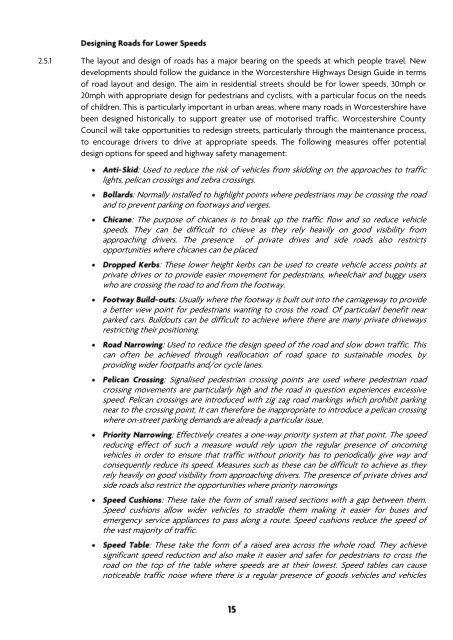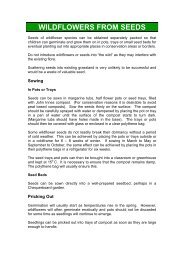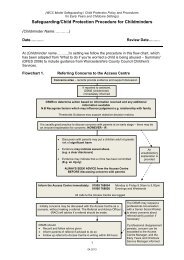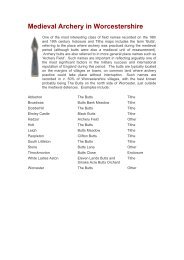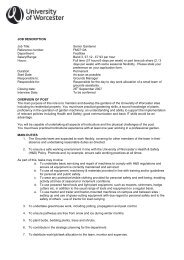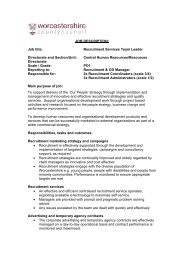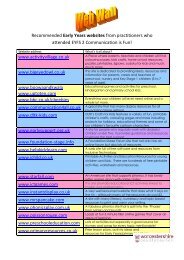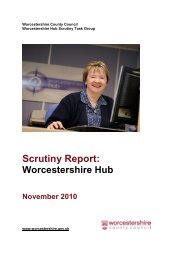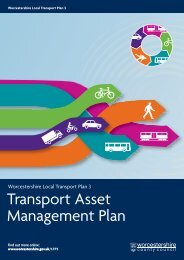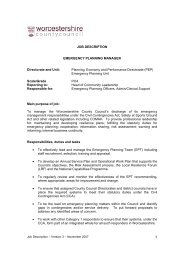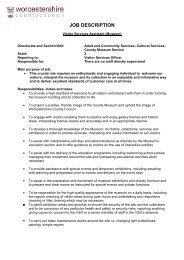Transport Safety Policy - Worcestershire County Council
Transport Safety Policy - Worcestershire County Council
Transport Safety Policy - Worcestershire County Council
Create successful ePaper yourself
Turn your PDF publications into a flip-book with our unique Google optimized e-Paper software.
2.5.1 The layout and design of roads has a major bearing on the speeds at which people travel. Newdevelopments should follow the guidance in the <strong>Worcestershire</strong> Highways Design Guide in termsof road layout and design. The aim in residential streets should be for lower speeds, 30mph or20mph with appropriate design for pedestrians and cyclists, with a particular focus on the needsof children. This is particularly important in urban areas, where many roads in <strong>Worcestershire</strong> havebeen designed historically to support greater use of motorised traffic. <strong>Worcestershire</strong> <strong>County</strong><strong>Council</strong> will take opportunities to redesign streets, particularly through the maintenance process,to encourage drivers to drive at appropriate speeds. The following measures offer potentialdesign options for speed and highway safety management:: Used to reduce the risk of vehicles from skidding on the approaches to trafficlights, pelican crossings and zebra crossings.: Normally installed to highlight points where pedestrians may be crossing the roadand to prevent parking on footways and verges.: The purpose of chicanes is to break up the traffic flow and so reduce vehiclespeeds. They can be difficult to chieve as they rely heavily on good visibility fromapproaching drivers. The presence of private drives and side roads also restrictsopportunities where chicanes can be placed: These lower height kerbs can be used to create vehicle access points atprivate drives or to provide easier movement for pedestrians, wheelchair and buggy userswho are crossing the road to and from the footway.: Usually where the footway is built out into the carriageway to providea better view point for pedestrians wanting to cross the road. Of particularl benefit nearparked cars. Buildouts can be difficult to achieve where there are many private drivewaysrestricting their positioning.: Used to reduce the design speed of the road and slow down traffic. Thiscan often be achieved through reallocation of road space to sustainable modes, byproviding wider footpaths and/or cycle lanes.: Signalised pedestrian crossing points are used where pedestrian roadcrossing movements are particularly high and the road in question experiences excessivespeed. Pelican crossings are introduced with zig zag road markings which prohibit parkingnear to the crossing point. It can therefore be inappropriate to introduce a pelican crossingwhere on-street parking demands are already a particular issue.: Effectively creates a one-way priority system at that point. The speedreducing effect of such a measure would rely upon the regular presence of oncomingvehicles in order to ensure that traffic without priority has to periodically give way andconsequently reduce its speed. Measures such as these can be difficult to achieve as theyrely heavily on good visibility from approaching drivers. The presence of private drives andside roads also restrict the opportunities where priority narrowings: These take the form of small raised sections with a gap between them.Speed cushions allow wider vehicles to straddle them making it easier for buses andemergency service appliances to pass along a route. Speed cushions reduce the speed ofthe vast majority of traffic.: These take the form of a raised area across the whole road. They achievesignificant speed reduction and also make it easier and safer for pedestrians to cross theroad on the top of the table where speeds are at their lowest. Speed tables can causenoticeable traffic noise where there is a regular presence of goods vehicles and vehicles


